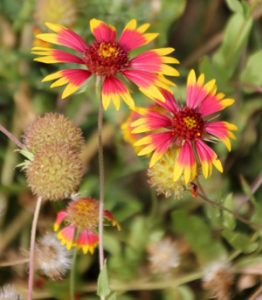
With brightly colored daisy-like flowers in shades of red, orange, and yellow, the heat-tolerant and heavy blooming blanket flower is a good addition to the informal garden. There are about 25-30 species of Gaillardia, a genus of annuals, biennials, and perennials in the sunflower family (Asteraceae) all native to the Americas. The common name blanket flower may have come from the resemblance of the flowers to brightly patterned Native American blankets in similar colors, the ability of wild species to completely cover the ground with a blanket of color, or even to the legend of a Native American weaver whose grave was always covered with blooming flowers that were as brilliantly colored as the blankets he had made.
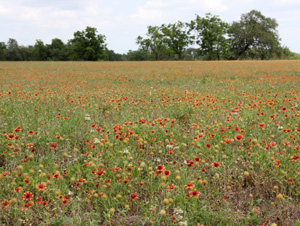
The genus was named after French naturalist Antoine Rene Gaillard de Charentoneau. The first species described in 1788 was the annual G. pulchella (= G. drummondi, G. bicolor), native from the southeastern US through to Colorado and south into Mexico, with its 2-inch flowers of red with yellow tips. Lewis and Clark collected the much larger-flowered, short-lived perennial G. aristata in Montana in 1806, with its variable fringed flowers in reds and yellows. These two species hybridized in a Belgian garden in 1857 to produce Gaillardia x grandiflora, the most common type of blanket flower grown in gardens. This hybrid has the best characteristics of both parents: large flowers, a perennial habit, good tolerance to heat, drought, and poor soil, and cold hardiness. Although more vigorous than the species, they do tend to be relatively short-lived perennials, however.

The flowers of all Gaillardia species are comprised of many small central disc flowers surrounded by 15 or more sterile ray flowers (although a few species lack ray flowers). The ray flowers usually are long and flat like petals with three-toothed tips, but in some they may be curled up like trumpets.
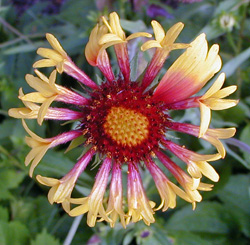
Each flower head can appear single or double, with either a classic daisy form, or with the central disc filled with trumpet-shaped, 5-petaled flowers. The ray flowers often have bands of color, typically with the outer half yellow and the rest of the ray red, orange, or maroon. In other varieties the entire flower head is the same color or they may have solid-colored rays with a different colored central disc. The 2-4“ flowerheads are produced individually on stems held just above the foliage.
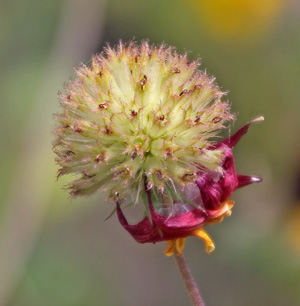
The mounding or slightly sprawling plants are covered in summer and fall with flowers that butterflies and native bees love to visit. The taller cultivars make nice cut flowers. The flowers age to form a globular, fuzzy-looking head filled with seeds that may be eaten by birds (especially goldfinches), or fall to the ground to self-sow.

The alternate, gray-green leaves on these plants are generally big, soft and hairy, and strap-shaped. The edges vary from smooth to toothed to lobed, and all types can occur on the same plant. The leaves contain compounds (lactones) that can cause contact dermatitis in susceptible individuals, so gloves should be worn when handling the plants.
Although the species are appropriate in dry prairie or meadow gardens and will naturalize under ideal conditions – and may be included in wildflower seed mixes – most gardeners grow some form of Gaillardia x grandiflora.
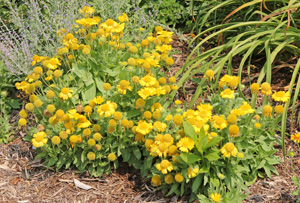
These make colorful additions to perennial borders or mixed beds, and in cottage gardens. The compact cultivars are excellent massed at the front of borders. They can be used in containers, alone or in combination with other plants that tolerate dry conditions. Combine blanket flower with ornamental grasses, and intersperse with gray- or blue-foliaged plants to tone down the hot colors of the blanket flowers. They can be stunning when planted with blue or purple flowering plants. Their texture contrasts nicely with strappy daylily foliage or the very fine foliage of yarrow. They work well with coreopsis, sunflowers and purple coneflower, for a profusion of daisy-like flowers, and mix nicely with other North American natives such as Liatris and Rudbeckia.
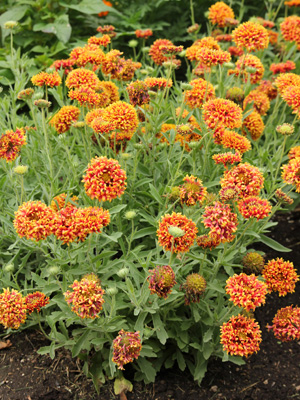
Grow all types of gaillardias in full sun and sandy, fast-draining soils. They rarely survive the winter in heavier soil, so need to be grown on berms or in containers if that is all you have. They tend to be short lived (average lifespan for Gaillardia x grandiflora is two years) not only because of this requirement for excellent drainage, but also because they bloom so prolifically that they burn themselves out quickly. Deadheading is not necessary but will help prolong the plants life by not allowing them to put energy into producing seeds. It will keep the plant looking tidier and may encourage additional blooms. Cutting the plants back to 6 inches in late summer may increase the chance of winter survival. Plants benefit from mulching (or snow cover) in very cold winters but most will survive to -20° F without crown protection (as long as drainage is good). Once established, they are drought tolerant and do not require much fertilization. These plants have few pest problems, although they are susceptible to aster yellows and powdery mildew. Deer and rabbits usually avoid blanket flower.
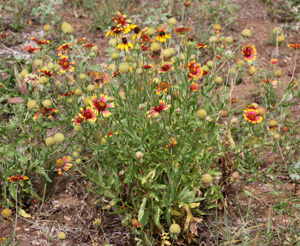
The species and some hybrids are easily propagated from seed, and will often self sow. Scatter the seed of annual types on the soil surface (they need light to germinate) where you want them to grow – but mark the area so you know where to expect them and don’t inadvertently pull them out, as the seedlings resemble young dandelions. For perennial types, start indoors about 6-8 weeks before the average last frost (they generally take 4-5 months from sowing to flowering) and annual types 4-6 weeks before the average last frost. Transplant annuals outdoors just after the last frost; set perennials out a bit later. Named varieties are propagated from basal cuttings or by division. If the plants survive long enough, divide in spring or early fall every 2-3 years to improve vigor.
Species and varieties
Gaillardia aristata
This robust, large-flowered perennial native to the prairies of North America and into the Rocky Mountains has yellow rays that are often red-orange at the base; the central disc is usually red-orange too. Zones 3-10. Some of the more common cultivars include:
-
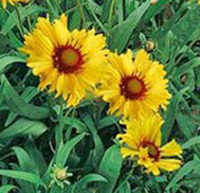
‘Amber Wheels’
‘Amber Wheels’ has fringed yellow ray flowers and a amber-red center. - ‘Maxima Aurea’ has yellow rays and a darker yellow disc. It grows about 20 inches high and wide.
- The Sunrita series is more compact (18 inches tall) with 3- to 4-inch flowers including dark red with just an edge of yellow (‘Sunrita Burgundy’), bright red with yellow tips and a dark center (‘Scarlet Halo’) and pure yellow.
Gaillardia pulchella
This annual species can grow up to three feet tall, with lots of small all red, all yellow flowers, or yellow-tipped red ray flowers with dark purple disc florets. Plants generally begin flowering just three months after sowing. The species tends to flop without support, but named varieties tend to be less rangy.
-

‘Red Plume’
‘Lollipop’ grows to 18” tall with interesting combinations of yellow, red and orange flowers. - ‘Red Plume’ is an AAS winner (1991) with double flowers on 112-18 inch tall plants. ‘Yellow Plume’ is similar, but with all yellow flowers.
Gaillardia x grandiflora
This hybrid of the two species above is quite variable, growing up to 3 feet tall (but tends to flop, so those tall types need support), but breeders are developing more compact cultivars, as well as flowers in single colors, tubular ray flower, and double flowers. There are numerous cultivars, with more being introduced all the time. Zones 3-10, but hardiness may vary depending on the variety. The following are just some of the more commonly available cultivars:
- The Arizona series, at 12 inches tall and with flat rays, includes two All-America Selections winners. ‘Arizona Sun’ (2005) has bright yellow ends on the red ray flowers and a red center, while ‘Arizona Apricot’ (2011) has soft-orange flowers with yellow tips and a yellow center. ‘Arizona Red Shades’ has rosy red rays with yellow centers. They bloom sooner than many other cultivars. Zones 3-9.
- ‘Burgundy’ (= ‘Burgunder’) has deep, wine-red ray flowers that soften in color as they age, and a yellow center that ages to dark red, on 24-30” plants. It self-sows reliably and is hardy in zones 3-9.
- ‘Dazzler’ is 12 inches tall with golden yellow tipped red ray flowers.
- The Fanfare series is a bit taller than many other dwarf types (14”), with single flowers with trumpet-shaped rays. The series includes ‘Fanfare’ (scarlet trumpets with flared yellow tips and a rosy to burnt orange center), ‘Fanfare Blaze’ (red-orange trumpets and red and yellow center), ‘Fanfare Citronella’ (yellow trumpets, red disc), and ‘Fanfare Regal’ (red trumpets, yellow disc). Zones 4-10.
-
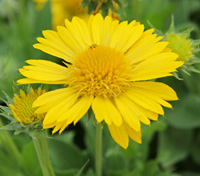
‘Mesa Yellow’
‘Goblin’ (=‘Kobold’) is an older variety with flat red rays tipped with yellow on a 12-14” high plant. ‘Golden Goblin’ (=’Goldkobold’) is an all-yellow version. Self seeds freely. Zones 3-10
- The Lunar series is very short at 8-10 inches tall and flowers with flat rays. Harvest Moon has yellow rays with red base and central disc, while Two Moon is red with yellow tips.
- The Mesa series has very uniform, well-branched plants at 16-18” high with flat ray flowers in several colors, including the AAS winner (2010) Mesa Yellow, which comes true from seed and blooms the first year.
- ‘Oranges and Lemons’ is a sterile, midsized cultivar (18-24”), with single flowers in softer colors than most other blanketflowers, with peach-orange trumpet-shaped rays with yellow tips and a gold center. Zones 5-10
-
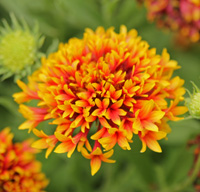
‘Sundance Bicolor’
‘Sundance Bicolor’, another AAS winner (2003), is a double-flowered cultivar with a low trailing habit. The 2” double, globe-shaped blossoms have tubular petals with flared tips. The coloration is quite variable, even on a single plant, ranging from nearly all red to nearly all yellow on certain flowers, and both colors in vary amounts on others. - The Sunset series includes dwarf plants of 14” high or medium (16-18”) in a variety of bicolors including Sunset Cutie (bronzy red with cream border), Sunset Flash (red-orange with yellow tips), Sunset Snappy (purple pink rays with cream-yellow tips), Sunset Candy (pink, cream border), Sunset Mexican (yellow rays with pink base), Sunset Popsy (deep pink, cream-yellow tips), Sunset Spice (red orange, yellow tips), and Sunset Sunrise (yellow rays, orange bases, red-orange centers).
- ‘Tokajer’ is tall (3 feet) with orange-red flowers.
– Susan Mahr, University of Wisconsin – Madison





 ▶︎ Watch: Fall Bulb Planting
▶︎ Watch: Fall Bulb Planting Aster, Symphyotrichum spp.
Aster, Symphyotrichum spp. Fascinating Fasciation
Fascinating Fasciation Alternatives to Lawn: Groundcovers
Alternatives to Lawn: Groundcovers


